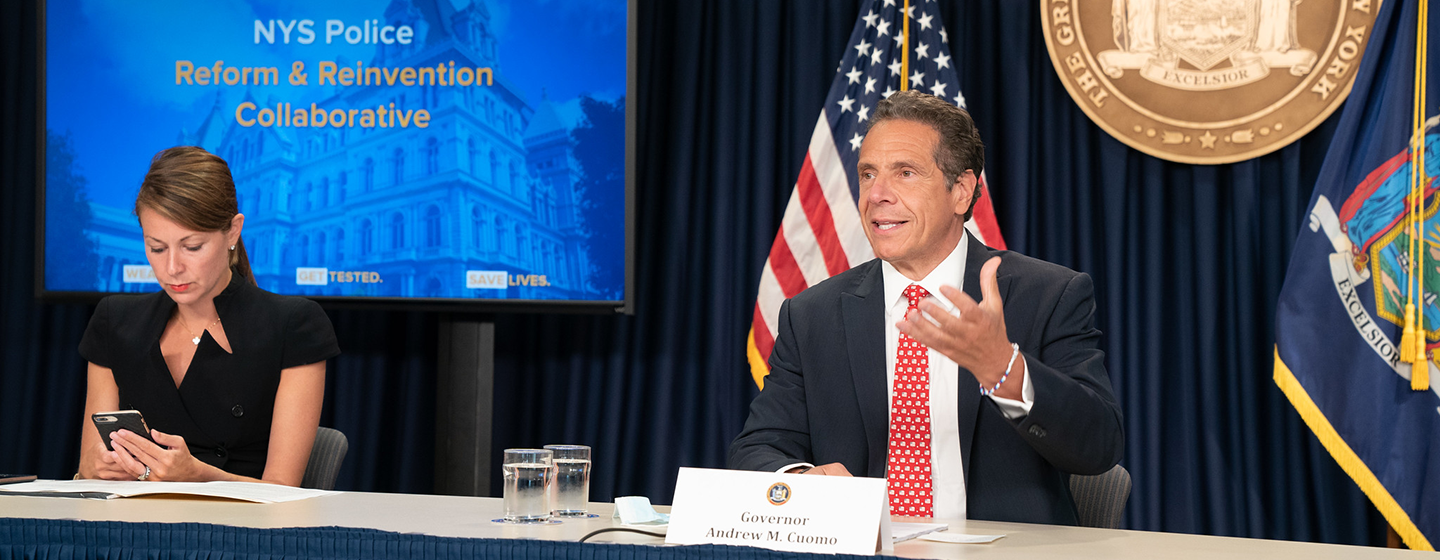Local Gov’ts Without Police Reform Plan Risk State Monitor, Funding Cuts Under Budget Deal

Police Reform in New York State
Monitors could be installed by the state in localities that have yet to approve a state-mandated plan to improve relations between members of law enforcement and the communities they serve, as required by an order last year from Gov. Andrew Cuomo.
The plan, which is included in this year’s state budget, would allow the state to appoint those monitors, but require localities to foot the bill for their work.
“Such monitor shall be appointed by the attorney general, in consultation with the governor, at the expense of the police agency or responsible government,” the legislation says.
At the same time, the state would have the option to withhold funding from those local governments until they’ve approved a police reform plan. Up to half of a locality’s funding from the state could be withheld, according to the deal.
That funding would be restored by the state Division of Budget after the local government submits its police reform plan to the state.
After the death of George Floyd last year, Cuomo ordered local governments in New York to work with members of law enforcement and members of their communities to develop a new plan that would address inequities in policing while maintaining public safety.
That order was intended to force local governments to the table with constituents and members of law enforcement in a way that would “reinvent” policing in New York, as it was defined by Cuomo at the time.
But the order didn’t require a specific outcome. Localities were required to certify that their plan was intended to “improve policing,” but it was up to the community to define what that meant.
That was by design. The Cuomo administration didn’t want to mandate a specific outcome for communities, but wanted municipal leaders to collaborate with stakeholders to assess the future of their law enforcement strategies.
The mandate applied to any local government with a police agency, from New York City to Albany County, and even small towns in rural counties.
Local governments were required to request community input on their proposed police reform plans, approve it through their legislative body, and submit it to the state for approval. Those plans were due April 1.
And, as of Monday, most local governments had completed the process, according to Cuomo.
Cuomo, in a conference call with reporters, said the state had received about 450 plans from local governments around the state. That’s about 90% of the local governments the order applied to, Cuomo said.
But he also said he didn’t expect the conversation to end in those communities just because they’d checked a box with the state.
“I am not saying that every plan is the be all and end all. I think some of the plans are just the first step,” Cuomo said. “And we'll need further advancement and refinement.”
The plans have varied widely, in terms of ideology and strategy.
In Ithaca, considered a progressive carve-out of upstate New York, the city has opted to scrap the police department altogether and replace it with a new Department of Community Solutions and Public Safety.
The new department will include a mix of armed police officers and unarmed first responders who will be trained to de-escalate situations without the use of force.
Other communities have taken a radically different approach to the mandate.
The village of Malone in the North Country developed a plan that appeared to label Black people as transient to the municipality and dismissed the idea that implicit bias, or systemic racism, can impact policing.
The Ithaca plan was approved, while trustees in Malone ended up sending a revised version of its strategy to the state.
Related
Ava Ayers from the Government Law Center at Albany Law School has an update.
Recent criminal justice reform laws have created a new need for more state funding.
The state Legislature returns to Albany to approve a package of police reform bills.


